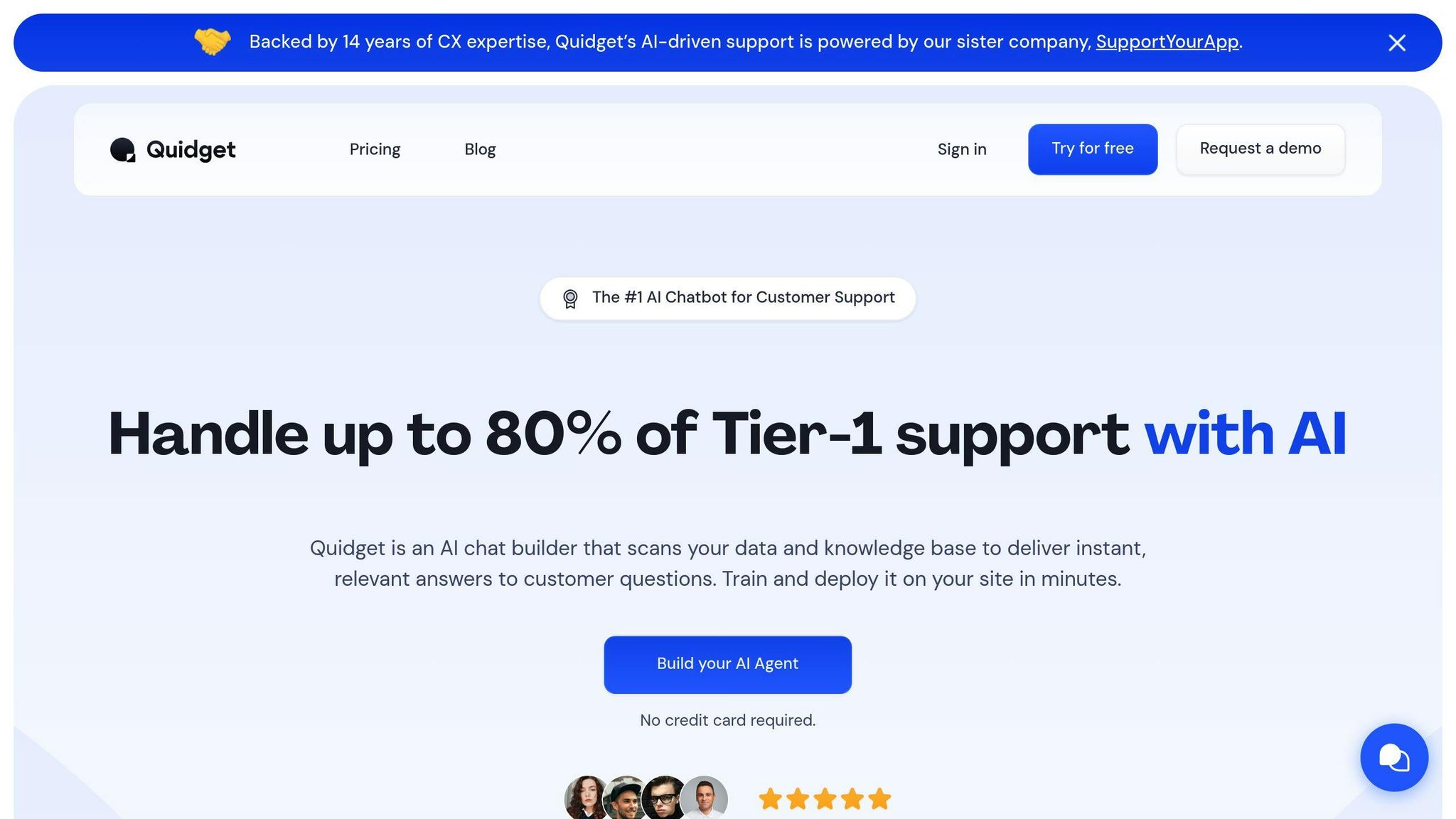AI chatbots often sound robotic due to issues like lack of context awareness, emotional insensitivity, and rigid conversation paths. These flaws lead to disconnected, repetitive, or cold responses that frustrate users. Fixing this involves:
- Using NLU and LLMs: These technologies help chatbots understand natural language and context, reducing misunderstandings by up to 60%.
- Adding Context Awareness: Personalize responses by remembering user history and tailoring replies accordingly.
- Incorporating Sentiment Analysis: Detect emotions to adjust tone and respond empathetically.
For example, tools like Quidget AI simplify chatbot development with features like multi-language support and smart escalation. By addressing these issues, businesses can create chatbots that feel more human, improving customer satisfaction, trust, and retention.
Reasons AI Chatbots Sound Robotic
Chatbot Development: From Rules to AI

The journey of chatbot technology sheds light on why some still sound mechanical. Although tools like NLU (Natural Language Understanding) and ML (Machine Learning) offer advanced capabilities, many businesses don’t fully leverage them. As a result, some chatbots remain stuck in rigid, rule-based behaviors, struggling with unexpected queries or sounding overly scripted.
Common Design Flaws in Chatbots
Several design issues play a major role in making chatbot interactions feel unnatural:
- Lack of Context Awareness: Many chatbots treat each message as standalone, ignoring the conversation history. This often leads to responses that feel disconnected or repetitive.
- No Emotional Sensitivity: Without sentiment analysis, chatbots fail to pick up on emotional cues, which can result in responses that come across as cold or inappropriate.
- Fixed Conversation Paths: Predefined scripts limit a chatbot’s ability to handle natural, flowing conversations. This rigidity can lead to irrelevant or repeated replies.
These flaws collectively create robotic interactions that can frustrate users.
Effects of Robotic Responses on Customers
Robotic chatbot interactions don’t just annoy customers – they can hurt businesses. Zendesk’s CX Trends 2023 report highlights key areas where this happens:
| Impact Area | Effect on Business |
|---|---|
| Customer Satisfaction | Responses lacking empathy lead to lower satisfaction. |
| Brand Perception | Poor interactions reduce trust in digital services. |
| Customer Retention | Frustrated customers are more likely to switch to competitors. |
This is especially problematic in industries like e-commerce, where customer experience is directly tied to revenue. If chatbots can’t deliver natural and empathetic interactions, businesses risk losing both customers and market share.
To overcome these issues, companies need to focus on creating chatbots that are more human-like, emotionally aware, and capable of understanding context.
How to Make a Chatbot More Human
Ways to Improve AI Chatbot Conversational Quality
Modern AI chatbots can feel surprisingly natural when fine-tuned effectively. Here’s how businesses can make their chatbots sound less robotic and more like engaging conversational partners.
Leveraging NLU and LLMs for Smarter Interactions
Natural Language Understanding (NLU) and Large Language Models (LLMs) are the backbone of conversational AI. Unlike older keyword-based systems, these technologies allow chatbots to interpret a wide range of phrasing, making it easier to understand what users mean and respond accurately.
By combining NLU and LLMs, chatbots can pick up on subtle meanings and deliver responses that fit the context. When implemented well, they can cut down misunderstandings by up to 40-60% while keeping the conversation smooth and natural.
But understanding language isn’t enough – chatbots also need to be aware of the context to provide truly relevant and personalized responses.
Making Conversations Personal with Context Awareness
Context awareness takes chatbot interactions to the next level by analyzing user history, preferences, and the details of the current conversation. This allows chatbots to tailor their responses, making them feel more personal and less generic.
For example, a chatbot might remember a user’s previous questions or preferences and use that information to provide more meaningful replies. This approach makes conversations feel more fluid and human-like.
Beyond context, recognizing the user’s emotions can make interactions even more relatable and effective.
Bringing Empathy Through Sentiment Analysis
Sentiment analysis equips chatbots to pick up on emotional cues, adjust their tone, and even escalate issues to a human agent when necessary. This is especially valuable in customer service, where understanding emotions can lead to better responses.
For instance, chatbots can detect frustration and offer solutions while acknowledging the user’s feelings. They can also recognize positive emotions and reinforce them with encouraging replies. This blend of emotional awareness and problem-solving helps create more engaging and supportive interactions.
sbb-itb-58cc2bf
Tools to Improve Chatbot Performance
Enhancing the conversational quality of chatbots is crucial, but using the right tools can make the process smoother and more efficient. Today’s tools come packed with features that help create more natural, engaging interactions.
Quidget AI: A No-Code Chatbot Platform

Quidget AI tackles common issues like poor context awareness and limited emotional sensitivity. It simplifies chatbot development with features like multi-language support, round-the-clock availability, and smart escalation. By learning from your existing business content, it enables chatbots to provide more precise, context-aware responses, making customer support more efficient.
The platform also integrates seamlessly with widely-used platforms, ensuring consistent support across different channels. This makes it an accessible option for businesses of any size.
Other AI Chatbot Tools
Here are a couple of other tools that cater to specific needs:
- ChatBot focuses on advanced customization and analytics, helping businesses refine chatbot interactions for a more personalized experience.
- Chatfuel excels in managing complex conversations with its robust automation features.
When choosing a chatbot tool, think about factors like integration options, language processing capabilities, customization flexibility, scalability, and performance tracking. These elements play a major role in delivering chatbots that feel natural and intuitive.
Conclusion: Improving AI Chatbot Engagement
AI chatbots designed to feel more human can improve customer experiences and help businesses thrive. While automation works well for routine tasks, human agents are still essential for handling more complex situations. Striking the right balance between automation and human touch is key to effective customer service.
As mentioned earlier, advancements like NLU, LLMs, and sentiment analysis enable chatbots to better understand context and respond with empathy. Tools such as Quidget AI make it easier to upgrade chatbots, offering features like support for over 80 languages and smart escalation systems. These tools allow companies to deliver consistent support while cutting costs by up to 90%.
Research shows that chatbots with a human-like approach create stronger emotional connections and improve cooperation with users. This leads to higher satisfaction, better efficiency, and increased customer retention – all while keeping expenses in check. However, it’s crucial to avoid generic responses or missing context, as these can harm service quality.
Sentiment analysis plays a big role in helping chatbots detect emotions, enabling more empathetic and effective problem-solving interactions. The strategies and tools shared in this article offer a clear path for turning chatbots into more engaging and reliable resources.
As AI chatbots improve, the line between automated and human-like interactions becomes harder to distinguish. By focusing on these methods, businesses can elevate their chatbots to meet customer needs, build trust, and strengthen brand loyalty.
FAQs
How to make chatbots more human?
To make your chatbot feel more natural and engaging, blend advanced tech with user-centered strategies:
1. Develop a Unique Personality
Give your chatbot a name and personality that reflects your brand. This adds a personal touch and helps users feel more connected during interactions.
2. Use NLU and LLMs
Improve your chatbot’s responses by enabling it to:
- Grasp context and subtle nuances while keeping track of the conversation.
- Handle complex questions with precision.
- Deliver responses that are relevant and tailored to the user’s needs.
3. Incorporate Emotional Awareness
Add sentiment analysis capabilities so your chatbot can detect and respond to user emotions in a way that feels empathetic and thoughtful.
4. Build Natural Conversations
- Use varied language and natural pauses to mimic real dialogue.
- Be transparent about limitations when unsure.
- Seamlessly hand off to human agents when needed.
5. Enable Context Awareness
Program your chatbot to remember past interactions, allowing it to provide personalized answers and avoid repetitive or generic replies.
The goal isn’t to trick users into thinking they’re speaking with a human but to create interactions that are helpful, engaging, and natural for your audience.



